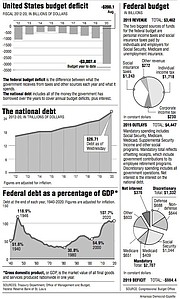WASHINGTON -- The U.S. budget deficit hit an all-time high of $3 trillion for the first 11 months of the current federal budget year, the Treasury Department said Friday.
The ocean of red ink is a product of government spending to try to cushion the impact of a coronavirus-fueled recession that has cost millions of jobs.
The deficit from October through August is more than double the previous 11-month record of $1.37 trillion set in 2009. At that time the government was spending large sums to get out of the recession that was triggered by the 2008 financial crisis.
With one month to go in the 2020 budget year, which ends Sept. 30, the federal deficit could go even higher. While the Congressional Budget Office is forecasting the deficit this year will hit a record $3.3 trillion, the government often runs surpluses in September so it is possible the final figure for this year could come in just under $3 trillion.
That would still put the deficit well above last year's imbalance of $984 billion. The previous record deficit for a fiscal year was $1.4 trillion in 2009 in the aftermath of the financial crisis.
Earlier this year, Congress passed a series of relief bills totaling nearly $3 trillion aimed at easing economic shutdowns resulting from the coronavirus pandemic that include a $600-a-week boost in unemployment benefits, up to $1,200 in payments to individuals and aid for small businesses trying to retain their workers.
However, many of the support programs ended in early August and efforts to approve another measure to restore the expired programs have so far failed in Congress. That is raising concerns among economists that with so many people still out of work and so many businesses struggling to reopen, any economic recovery could wither by late this year.
The budget deficit for the month of August totaled $200 billion, matching the August 2019 deficit and reflecting the fact that with relief programs expiring, the gains in monthly government spending slowed.
The Congressional Budget Office is forecasting that by the end of this year, the amount of government debt held by the public will equal 98% of the total economy and then next year it will exceed 100% of gross domestic product, the economy's total output of goods and services. That's a level not seen since the huge government debt buildup in the 1940s to pay for fighting World War II.
By comparison, the debt held by the public totaled 79% of GDP at the end of 2019 and stood at 35% of GDP in 2007 before the recession.
Accumulating deficits add to the overall federal debt, which totaled nearly $26.71 trillion as of Wednesday. That figure includes more than $6 trillion the government owes itself, including about $2.9 trillion borrowed from the Social Security Trust Fund, according to Treasury Department reports.
Even with huge amounts of debt being added, the government's interest costs to finance the debt at $484 billion, are actually down 10% this year compared with what the government spent on interest payments a year ago. Treasury officials said the lower figure is due to lower interest rates this year as the country went into recession.
Through August of this year, tax revenue totaled $3.05 trillion, 1.3% below the same period last year. Spending totaled $6.05 trillion, up from $4.16 trillion for the same period last year.
Receipts in August fell 2.1% from a year ago, while spending declined 1.2%, the Treasury Department report showed.
Outlays for federal additional unemployment compensation program totaled $22.5 billion, compared with $73.4 billion a month earlier, after the $600 supplemental weekly jobless payments ended in July. Outlays for state unemployment benefits totaled $31.2 billion after $36.1 billion in July.
Information for this story was contributed by Vince Golle of Bloomberg News

